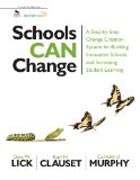
When it comes to school improvement, there is no silver bullet. Genuine effective school improvement requires leaders and teachers to be part of a broad-based, creative change system that focuses on generating improved teacher practices for enhancing student learning. Based on more than two decades of success with the Whole Faculty Study Group (WFSG) approach to professional learning, this leading-edge guide provides educators with a step-by-step, systemic change creation approach for: Forming action teams to develop teaching and learning approaches that measurably improve student performance Nurturing the right leadership, vision, culture, and relationships within schools for innovation and creativity The companion website includes practical online resources, including templates, checklists, action team assessment forms, and an action team rubric. INDICE: List of Figures and TablesOnline ResourcesForewordPreface Purpose and Need Who Should Read and Use This Book? Organization and ContentsAcknowledgmentsAbout the Authors1. The Change Creation System School Improvement School Reforms The Roots of the Change Creation System No Silver Bullet, One Brick at a Time Standards for Professional Learning and Practice The Change Creation System SummaryPart I. Fundamentals of Effectiveness2. Fundamentals of Effectiveness for School Improvement Understanding the Culture Culture of Discipline Culture of Change Creation Culture of Relationships and Collaboration Culture of Transformational Leadership Cultural Change Summary3. Fundamentals of Vision and Successful Change Vision Change Success and Failure of Change Effective Sponsorship in Schools Change and Resistance in Schools Universal Change Principle for Schools Summary4. Fundamentals for Creating Learning Teams and Professional Learning Communities Collaboration and Teamwork Action Teams and Professional Learning Communities Authentic Teams and Synergy Comentoring Teams Learning Teams Professional Learning Communities SummaryPart II. The Process of the Change Creation System5. Introducing the Decision-Making Cycle Action Teams Decision-Making Cycle Preparing to Start the Decision-Making Cycle Summary6. Identifying Student Learning Needs and Forming Action Teams Student Learning Needs That Action Teams Address How to Identify Student Learning Needs Form Action Teams and Select Student Needs to Address Selecting Student Needs to Address Support for Identifying Student Needs and Forming Action Teams Summary7. Introducing Action Teams Action Teams in the Change Creation System The Work of Action Teams Purposes of Action Teams Action Team Principles Action Team Process Guidelines Effective Action Team Meetings Action Teams as a Bundle of Changes Summary8. Support for Action Teams Keep the Focus on Student Learning Protect Time for Action Team Meetings Establish Routines Provide Regular, Frequent, and Constructive Feedback to Action Teams Understand the Developmental Stages of Action Teams Help Struggling Teams Move Forward Develop Communication Networks and Strategies to Share Action Teams' Work and Results Form Administrator Action Teams Summary9. Creating Team Action Plans Team Action Plan Creating Team Action Plans Support for Action Teams on Their Team Action Plans and Logs Summary10. Implementing Learning and Inquiry Cycles for Innovation and Improving Student Learning: Parts 1 and 2 Implementing Learning and Inquiry Cycles Supporting Learning and Inquiry Cycles for Innovation and Student Learning Summary11. Implementing Learning and Inquiry Cycles for Innovation and Improving Student Learning: Parts 3 and 4 Implementing Learning and Inquiry Cycles Supporting Learning and Inquiry Cycles for Innovation and Student Learning Summary12. Assessing the Impact of Action Teams and Sharing Results and Best Practices Assessing the Impact of Action Teams on Teacher Practice and Student Learning Sharing Results and Best Practices and Applying Lessons Learned Repeating the Decision-Making Cycle Each Year Supporting Assessing the Impact of Action Teams and Sharing Results and Best Practices SummaryEpilogueReferencesIndex
- ISBN: 978-1-4129-9874-1
- Editorial: Corwin
- Encuadernacion: Rústica
- Páginas: 256
- Fecha Publicación: 16/01/2013
- Nº Volúmenes: 1
- Idioma:
